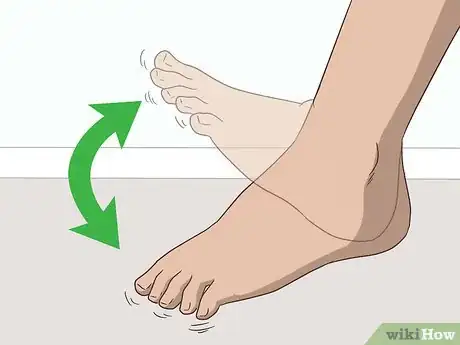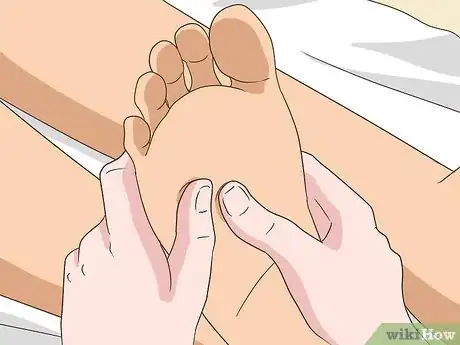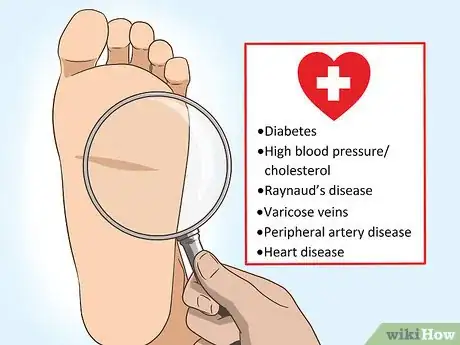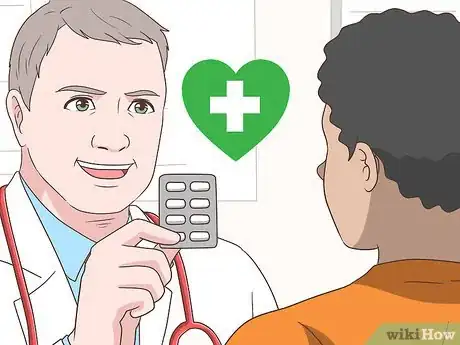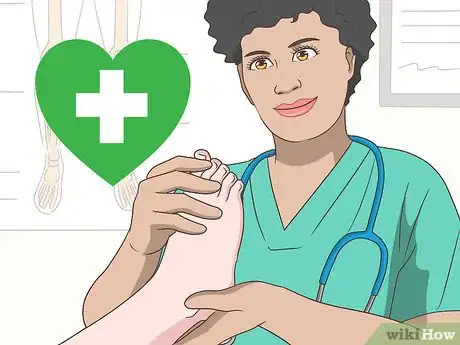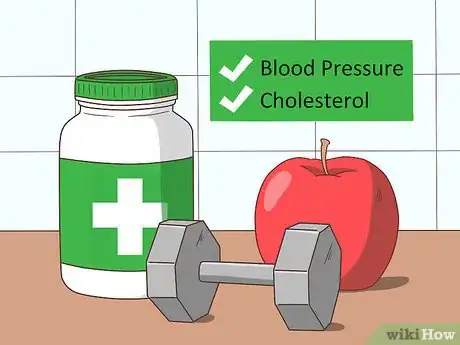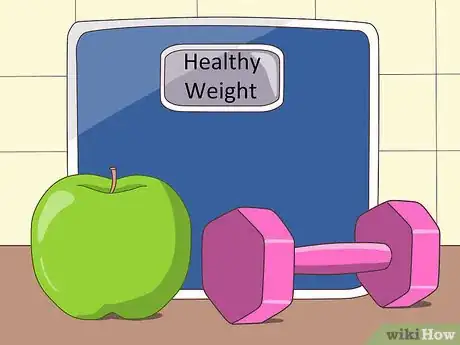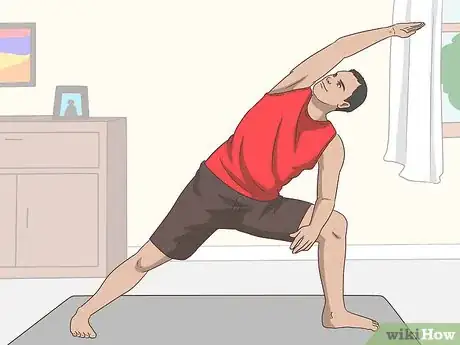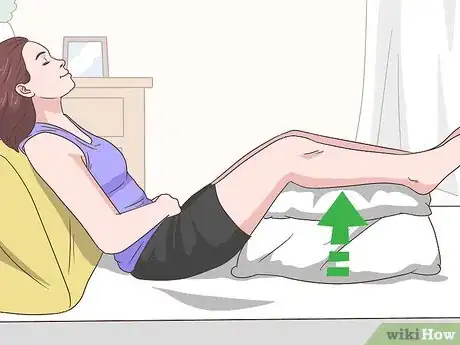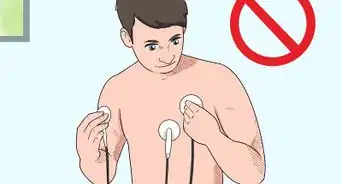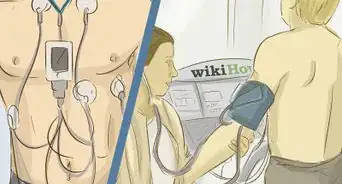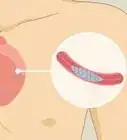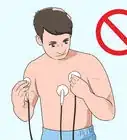This article was medically reviewed by Sarah Gehrke, RN, MS and by wikiHow staff writer, Jessica Gibson. Sarah Gehrke is a Registered Nurse and Licensed Massage Therapist in Texas. Sarah has over 10 years of experience teaching and practicing phlebotomy and intravenous (IV) therapy using physical, psychological, and emotional support. She received her Massage Therapist License from the Amarillo Massage Therapy Institute in 2008 and a M.S. in Nursing from the University of Phoenix in 2013.
There are 13 references cited in this article, which can be found at the bottom of the page.
This article has been viewed 97,271 times.
If your feet always seem to be cold, or you experience regular pain or numbness, take steps to improve your blood flow. Massage, support socks, and stretching your feet can help circulate blood. It's also important to work with your doctor to manage any condition that's reducing your circulation. Treat those conditions while making healthy lifestyle changes. Losing weight, lowering high blood pressure or cholesterol, or treating your diabetes will improve circulation in your feet.
Steps
Caring for Your Feet
-
1Move your feet and toes during the day. Make a habit of wiggling your feet and toes whenever you can remember. Rotate and move your ankles around to improve blood flow in your feet. Try to do this for a few minutes at a time.[1]
- Moving your feet and toes during the day is especially important if you spend most of the day sitting.
-
2Stretch your feet to strengthen them. Stand so your feet are together and move one leg back. Lift the heel of that foot so you're on your toes. Stretch and hold the muscles on the bottom of that foot for 20 to 30 seconds. Do the stretch with the other foot.[2]
- Stretch your feet throughout the day or whenever you remember to.
Advertisement -
3Massage your feet to stretch the muscles and improve blood flow. Get a professional massage that focuses on your feet, or massage your feet yourself. Sit comfortably and rub a little lotion or massage oil in your hand. Gently rub the bottoms of your feet, your toes, and your heels. Rub the muscles firmly and stretch the toes apart.[3]
- Massage your feet as often as you like. Consider buying foot massage devices or rollers that are designed to easily massage the muscles in your feet.
-
4Wear support socks. Ask your doctor if support hosiery would improve your circulation. Compression socks or stockings can improve the flow of blood from your feet throughout your body. To start wearing the socks, choose light support socks and ensure that they fit well without wrinkling.[4]
- Avoid using support socks if you have peripheral artery disease, since the socks can cut off your already reduced blood flow. If you have a sensory disorder like peripheral neuropathy, you may not be able to feel if the socks are too tight.
Getting Medical Treatment
-
1Talk with your doctor about your blood circulation. Schedule an appointment with your primary care physician if you think you have poor circulation in your feet. You might notice:[5]
- Cold or numb feet
- Pale blue color on your feet
- Hair loss or dry, cracked skin on the feet
- Toenails that break or tear easily
- Feet that fall asleep easily
- Swollen feet[6]
-
2Manage the condition that's causing the poor circulation. Your doctor will examine your feet, talk with you about your symptoms, and order blood work. Since several things can reduce circulation in the feet, it's important to find the cause of your poor circulation. Reduced circulation can be caused by:[7]
- Diabetes
- High blood pressure or cholesterol
- Raynaud's disease
- Varicose veins
- Peripheral artery disease
- Heart disease[8]
-
3Take medication to treat the condition that's causing poor circulation. Work with the doctor to create a treatment plan that's specific to you. You'll probably be prescribed medication that will improve the flow of blood to your feet or treat your condition. For example, if you have peripheral artery disease, you'll need to take pain relievers and blood thinners to improve circulation.[9]
-
4Get your feet examined every time you visit the doctor. Your doctor should check the muscles of your feet and do tests for sensitivity if you've had poor circulation. Let your doctor know if the shape of your feet have changed or if you've lost feeling in your feet.[12]
- If you have diabetes and experience severe problems with circulation, your doctor or podiatrist should examine your feet every 3 to 6 months.
Making Lifestyle Changes
-
1Stop smoking cigarettes. Take steps to quit or reduce the number of cigarettes you smoke. Smoking has been shown to reduce circulation in your feet, so quitting is an effective way to make your feet feel better.[13]
- You can also talk with your doctor about smoking cessation aids. Find support groups that you can contact if you're struggling to quit.
-
2Improve your blood pressure and cholesterol. If you have high blood pressure or high cholesterol, your blood vessels may become blocked or constricted. To improve blood flow to your feet, lower your high blood pressure or cholesterol by taking medications, exercising, and eating a healthy diet.[14]
- Your doctor may want to treat you for peripheral arterial disease (PAD) if you have poor circulation and high blood pressure or cholesterol.
-
3Manage your weight. If you're overweight, the excess weight can block or weaken the veins in your legs and feet. Exercise and eat a healthy diet in order to reach your healthy weight. Reducing the pressure on your heart and feet will improve your circulation.
-
4Exercise your body throughout the week. Get blood flowing to your feet by being active and avoiding long periods of sitting. Try to exercise a few times a week. For example, you can walk, dance, do yoga, stretch, swim, or ride your bike.[15]
- If your feet hurt, you might want to avoid high-impact activities such as basketball that require you to jump and land on your feet.
-
5Raise your legs when you rest. When you do sit down or rest, prop your legs up with a cushions or pillows underneath them. Elevating your legs prevents blood from pooling and setting in your feet.[16]
- For a quick way to elevate your legs, lean back in a recliner and extend the leg rest.
References
- ↑ https://www.niddk.nih.gov/health-information/diabetes/overview/preventing-problems/foot-problems
- ↑ https://www.health.harvard.edu/healthbeat/exercises-for-healthy-feet
- ↑ https://www.health.harvard.edu/mind-and-mood/foot-massage-the-pause-that-refreshes-and-it-good-for-you
- ↑ http://www.berkeleywellness.com/self-care/over-counter-products/article/rough-guide-compression-stockings
- ↑ https://www.diabetes.co.uk/diabetes-complications/poor-blood-circulation.html
- ↑ https://www.ncbi.nlm.nih.gov/pubmedhealth/PMH0072593/
- ↑ https://www.belmarrahealth.com/poor-circulation-feet-causes-symptoms-treatment/
- ↑ https://www.ncbi.nlm.nih.gov/pubmedhealth/PMH0072593/
- ↑ https://www.diabetesselfmanagement.com/managing-diabetes/complications-prevention/improving-blood-flow-to-the-feet/
- ↑ https://www.mayoclinic.org/diseases-conditions/peripheral-neuropathy/diagnosis-treatment/drc-20352067
- ↑ https://www.mayoclinic.org/diseases-conditions/raynauds-disease/diagnosis-treatment/drc-20363572
- ↑ https://www.niddk.nih.gov/health-information/diabetes/overview/preventing-problems/nerve-damage-diabetic-neuropathies
- ↑ https://www.niddk.nih.gov/health-information/diabetes/overview/preventing-problems/foot-problems
- ↑ https://www.nhlbi.nih.gov/health/educational/pad/materials/pad_extfctsht_general.html
- ↑ https://www.niddk.nih.gov/health-information/diabetes/overview/preventing-problems/foot-problems
- ↑ http://www.veinspecialists.com/blog/elevate-your-legs/
About This Article
If your feet are always cold, or if they get numb easily, you’ll probably want to take steps to improve your circulation. Stretch your feet a few times throughout the day or move them around whenever you can. You can also massage the muscles in your feet to improve your circulation. Wearing support stockings is another good way to improve your blood flow throughout the day. If your circulation doesn’t improve, make sure to talk to your doctor. To learn how to manage your weight to improve your circulation, read more from our Medical co-author!
